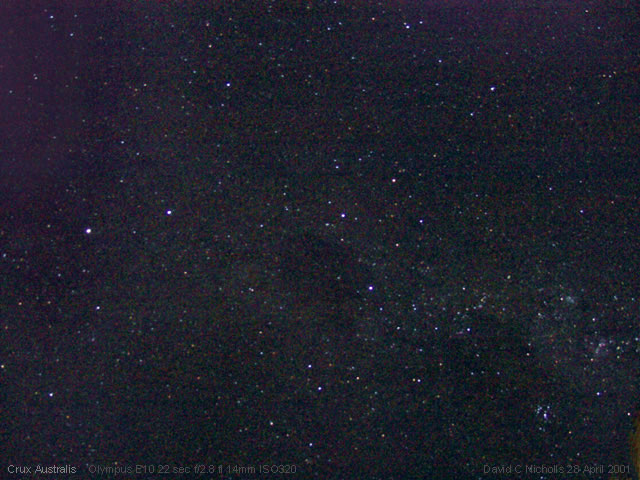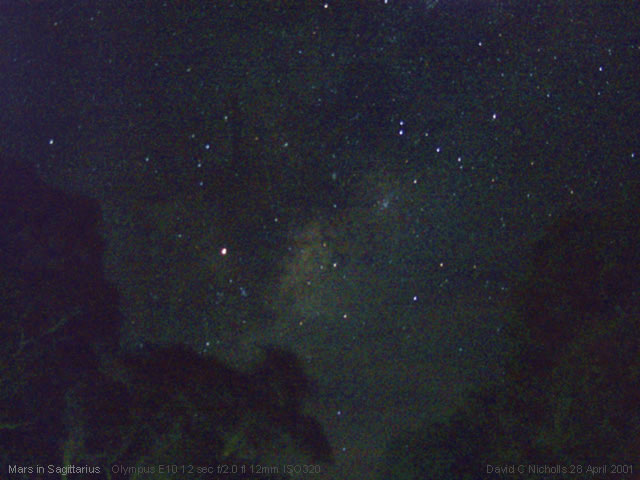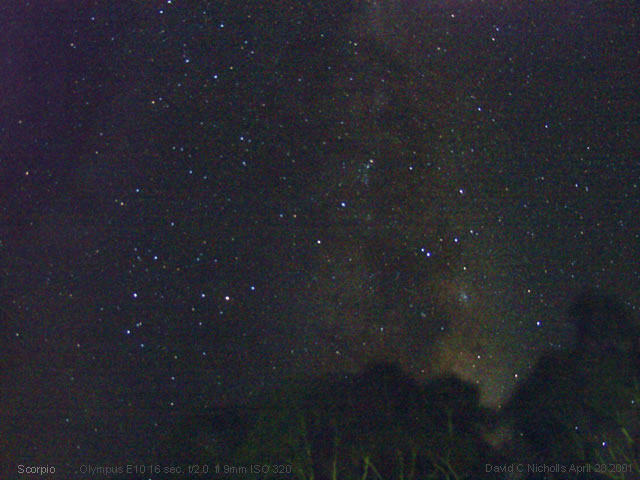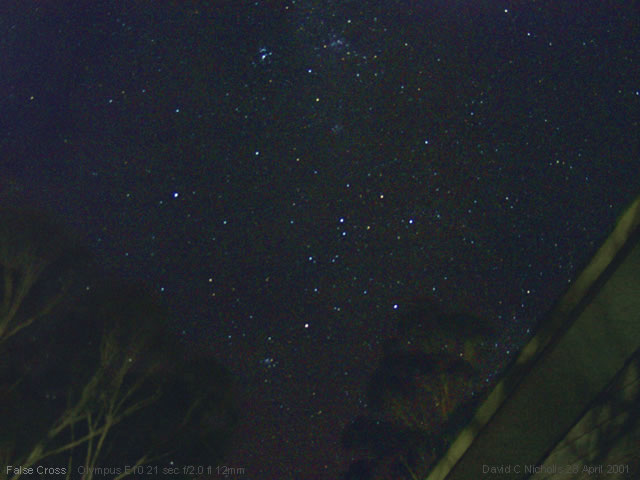Night-sky photography with the Olympus E10
About the images
The photographs on this page are first experiments using the Olympus E10 to photograph the night sky. They were taken at Merimbula, New South Wales on April 28 2001 around midnight. The night was moonless and very dark, with a cool westerly wind blowing.
The exposures vary between 16 and 22 seconds, and were taken on a fixed tripod with no star tracking. Each image is from a single exposure.
The photographs were manipulated in Photoshop 6 and converted to JPEG format in Fireworks 4*. The exposure information for each image is included at the bottom of the frame. All images were taken at ISO320, which (of course) generates a good deal of pixel noise. In every image, the red noise pixels appear to be emphasized. The images were all taken at the SHQ setting with contrast and sharpness set to normal. It is probable that some of the fainter stars are in fact stuck pixels, but these are relatively few. The final images have been blurred using a Gaussian blur to reduce JPEG file size. The original images are sharper and more dramatic, but would take forever to download if left that way.
Viewing the images
The images are 640x480 pixels and between 48 and 80 KB each so they will take a little while to download, but this is necessary to show the image detail. They are intended for viewing on a PC with Gamma around 2.22, so if you are using a Mac, please adjust your settings if possible. Maximise your browser window to see them properly.
Because every PC has its brightness and contrast set slightly differently, it's hard to ensure that photographs look the way you wish. To see the photographs on this page to best advantage, examine the contrast strip below: adjust your contrast setting to maximum and set the brightness so that you can barely distinguish the last and second last squares. There's no substitute for a properly calibrated top quality monitor, however.
Comments on using the camera
I found it quite difficult to focus the E10 on infinity consistently. The results using both manual and autofocus were quite variable. It appears that the maximum exposure possible on the Bulb setting is around 30 seconds. On the other hand, the camera is very easy to use for this purpose and it is possible to get very quick feedback by viewing the images on a Notebook PC. This is a vast improvement on color film! The Olympus lens shows remarkably low coma and chromatic aberration. Most distortion is due to slight movements of the camera while I held the shutter button down by hand, or due to the movement of the stars during the exposure. On my E10, at the top left corner and an area at top right of each image there is what would be called fogging in a film camera. This is quite noticeable when pushing the image to extremes in Photoshop, and occurs on all images, apparently regardless of exposure length. I reduced this by using a null image (with lens cap on) as a mask in Photoshop. I used the same method to reduce the pixel noise. However, both sources of noise are visible in the images. In two images, horizontal streaking shows up against the Milky Way glow, presumably caused by variable sensitivities in the CCD elements.
These photographs are pushing the camera to its limits, and don't reflect badly on it. It wasn't intended as an astrograph, and I was delighted it performed so well.
The images
Image 1. The Southern Cross, showing the shadowy Coalsack nebula below it and to the left. The two bright stars to the left are Alpha and Beta Centauri. The bluish fogging shows up clearly because I pushed the image as far as possible to show the Coalsack against the Milky Way. This image is a very close likeness of the naked eye view. The star colors are real, and the glow of Hydgrogen-alpha gas clouds shows as greyish patches (right side of image) instead of pink, in part because of corrections necessary to remove the red tinge to the background in the opriginal. (The red mark at bottom right is due to an incompletely removed segment of house eave.)

Image 2. Mars in Sagittarius. This shows Mars (the brightest object, below and left of center) rising over wind-blown tree tops. Above it are the stars of the tail of the Scorpion. The center of the Milky Way galaxy is the yellowish region to the right of Mars. Slight image elongation is evident, due to the movement of the stars during the exposure or possibly camera movement.

Image 3. Scorpio. This shows the Scorpion lying on its side, again rising over trees, and accompanied by the Milky Way. The yellow-red glow is caused by the combined light of millions of stars. The color can be glimpsed by the naked eye only on the darkest of nights. The E10 has caught it very well. The dark patches in the Milky Way are caused by interstellar dust hiding the stars beyond. This photograph was taken with the camera at an angle to the horizon.

Image 4. The False Cross. This group of stars, slightly below the center, is sometimes mistaken for the Southern Cross. It is made up of stars in the constellations of Carina and Vela. The eaves of a house show to the lower right, and wind-blown trees frame the lower part of the image. Slight lengthening of the star images is due to the movement of the stars during the exposure, or camera jar (I'm not sure which).

I hope to improve my techniques further when I work out how to get a consistent method of focussing the camera on infinity. I have a number of similar images which I intend to combine in an experiment in noise reduction, probably using QImage Pro, when I learn how to use it effectively. I will post these as they become available.
Needless to say, all images on this page are Copyright © 2001 David C Nicholls. Email me if you wish to use them elsewhere.
David Nicholls
Canberra
29 April 2001
* Fireworks 4 has excellent JPEG compression tools, including selective low compression for text elements, as shown above. See the forthcoming book "Playing with Fire" by Linda Rathgeber and myself.